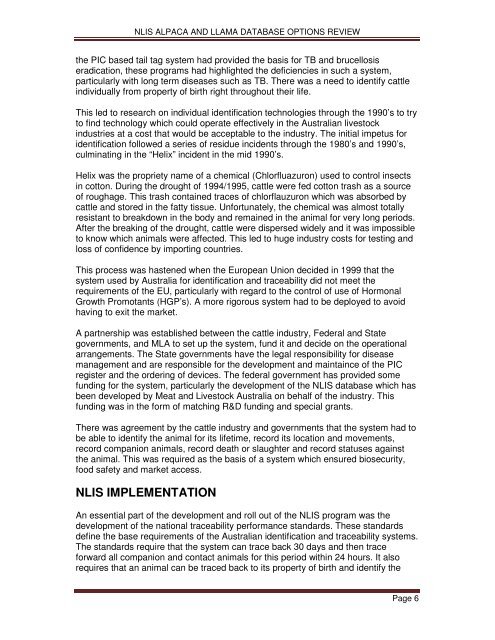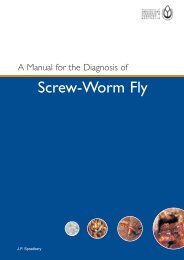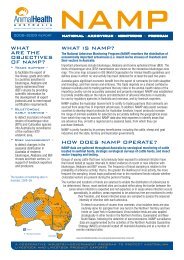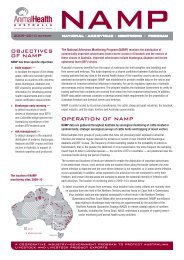National Livestock Identification System Alpaca and Llama ...
National Livestock Identification System Alpaca and Llama ...
National Livestock Identification System Alpaca and Llama ...
You also want an ePaper? Increase the reach of your titles
YUMPU automatically turns print PDFs into web optimized ePapers that Google loves.
NLIS ALPACA AND LLAMA DATABASE OPTIONS REVIEW<br />
the PIC based tail tag system had provided the basis for TB <strong>and</strong> brucellosis<br />
eradication, these programs had highlighted the deficiencies in such a system,<br />
particularly with long term diseases such as TB. There was a need to identify cattle<br />
individually from property of birth right throughout their life.<br />
This led to research on individual identification technologies through the 1990’s to try<br />
to find technology which could operate effectively in the Australian livestock<br />
industries at a cost that would be acceptable to the industry. The initial impetus for<br />
identification followed a series of residue incidents through the 1980’s <strong>and</strong> 1990’s,<br />
culminating in the “Helix” incident in the mid 1990’s.<br />
Helix was the propriety name of a chemical (Chlorfluazuron) used to control insects<br />
in cotton. During the drought of 1994/1995, cattle were fed cotton trash as a source<br />
of roughage. This trash contained traces of chlorflauzuron which was absorbed by<br />
cattle <strong>and</strong> stored in the fatty tissue. Unfortunately, the chemical was almost totally<br />
resistant to breakdown in the body <strong>and</strong> remained in the animal for very long periods.<br />
After the breaking of the drought, cattle were dispersed widely <strong>and</strong> it was impossible<br />
to know which animals were affected. This led to huge industry costs for testing <strong>and</strong><br />
loss of confidence by importing countries.<br />
This process was hastened when the European Union decided in 1999 that the<br />
system used by Australia for identification <strong>and</strong> traceability did not meet the<br />
requirements of the EU, particularly with regard to the control of use of Hormonal<br />
Growth Promotants (HGP’s). A more rigorous system had to be deployed to avoid<br />
having to exit the market.<br />
A partnership was established between the cattle industry, Federal <strong>and</strong> State<br />
governments, <strong>and</strong> MLA to set up the system, fund it <strong>and</strong> decide on the operational<br />
arrangements. The State governments have the legal responsibility for disease<br />
management <strong>and</strong> are responsible for the development <strong>and</strong> maintaince of the PIC<br />
register <strong>and</strong> the ordering of devices. The federal government has provided some<br />
funding for the system, particularly the development of the NLIS database which has<br />
been developed by Meat <strong>and</strong> <strong>Livestock</strong> Australia on behalf of the industry. This<br />
funding was in the form of matching R&D funding <strong>and</strong> special grants.<br />
There was agreement by the cattle industry <strong>and</strong> governments that the system had to<br />
be able to identify the animal for its lifetime, record its location <strong>and</strong> movements,<br />
record companion animals, record death or slaughter <strong>and</strong> record statuses against<br />
the animal. This was required as the basis of a system which ensured biosecurity,<br />
food safety <strong>and</strong> market access.<br />
NLIS IMPLEMENTATION<br />
An essential part of the development <strong>and</strong> roll out of the NLIS program was the<br />
development of the national traceability performance st<strong>and</strong>ards. These st<strong>and</strong>ards<br />
define the base requirements of the Australian identification <strong>and</strong> traceability systems.<br />
The st<strong>and</strong>ards require that the system can trace back 30 days <strong>and</strong> then trace<br />
forward all companion <strong>and</strong> contact animals for this period within 24 hours. It also<br />
requires that an animal can be traced back to its property of birth <strong>and</strong> identify the<br />
Page 6





